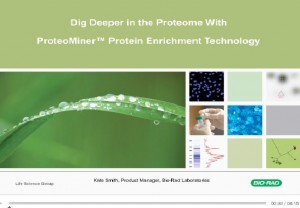As discussed in an earlier post, biomarker studies are quickly becoming the hottest research topic around. Many techniques such as 2D, SELDI and Mass Spectrometry are widely deployed in biomarker research. Nonetheless, whichever technique is utilized (a multifaceted approach is generally recommended as each technique contain its own set of advantages) adequate sample preparation is crucially important in obtaining accurate results.
Bio-Rad’s Proteominer technology is a fantastic tool for enriching low abundant proteins which helps identify the proverbial biomarker needle in the protein haystack. In this video, Kate Smith takes you on a tour of Proteominer Enrichment Technology and shows you how it will help you dig deeper into the Proteome.



